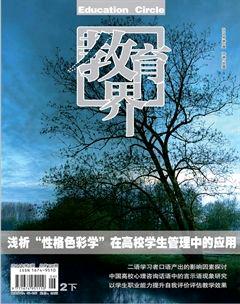翻譯批評賞析研究
黃婷
【Abstract】Through defining the differences between literary and non-literary translation and quoting some relating theories of aestheticalness, this paper sets the translation of Mr. Zhu Ziqing's famous prose 《荷塘月色》as an example to analyze how to transform the artistic conception into translation without any deviation to realize the true reciprocity in literary translation. It mainly explain the theory from three aspects: Phonological beauty,Symmetrical beauty and Conceptional beauty. It may have certain guiding meanings for the practices of literary translation.
【Key words】literary translation aesthetics sublimity synesthesia
ⅠRice's Functional Translation Theory
Rice, a representative of German Functional Translation Theory, thinks that not only the main idea of the text is needed while translating literary articles, but also its article form is necessary. All language forms in literary works have two functions: the expression of themes and aesthetic values. Therefore, we can clearly define literary translation as Artistic Creativity, and non-literary translation as Informative Transmission. Literary translation does not only bear the responsibility of conveying basic information of the original story like storyline, but it should also transmit the aesthetics. However the beauty of the original text is a relatively indefinite “variable”. Mr. Xie Tianzhen once cited《如夢令》written by a famous ancient Chinese writer Ms. Li Qingzhao: “昨夜雨疏風驟……卻道海棠依舊。知否?知否?應是綠肥紅瘦。” If the translator just use a kind of explaining language to convey its “referential meaning” like:“昨天晚上雨很大,風很大,把室外的海棠花吹打掉不少,但葉子倒長大了。” instead of the language that has aesthetic functions to recur the beauty of the original text, then readers cannot feel the aesthetic value of the article. In that case, the real task of literary translation is not completed.
Ⅱ The aesthetic analysis in literary translation: About “Moonlight over the Lotus Pond” and its translation
Here what this paper is going to analyze is about the translation of “荷塘月色”from a famous Chinese writer Zhu Ziqing. This prose is firstly published in the “Novel Monthly” on July 10th, 1927. The writer Mr. Zhu elaborated his night tour to the lotus pond in a sincere and delicate tone. It was even called an essay hovering with Mona Lisa's smile. The whole article is in a style of refinement, relieve and soothing. Under the premise of the writer's superb writing skills, the work fully shows the phonological beauty of Chinese language. Therefore, in order to successfully translate this beautiful prose, the translator needs to recur the artistic beauty of the original article before readers' eyes. That is to say, the translator should paint the same scenery using another language. Fortunately, the translation version “Moonlight over the Lotus Pond” analyzed in this paper is from Mr. Zhu Chunshen. Thus the translation bears the same aesthetic beauty with the original work. In the following, this paper is about to systematically analyze Mr. Zhu Chunshen's translation on how it reached a state of sublimity on several aspects.endprint
Ⅲ Evaluation and Analysis on Mr. Zhu Chunshen's translation:
The phonological beauty of the prose “荷塘月色”is seen mainly from the use of large amount of reduplicated words(疊詞), such as: “曲曲折折的荷塘”, “屢屢的清香”, “脈脈的流水”, “峭愣愣的黑影”; stack-sounding words(迭聲詞) such as: “裊娜”“仿佛”“渺茫”“斑駁”; and assonance words(雙聲疊韻詞) like: “零星”“宛然”“酣眠”“均勻”。 All these words showed us both visual and acoustic beauty, which makes us feel time and space remained unbroken. The beauty of Chinese language and the use of reduplicated words make the translation appealing to ear. In order to reach the effect of phonological reciprocalness, the translator should consciously avoid using words containing plosive or affricate sounds. Mr. Zhu Chunshen skillfully recurred the phonological beauty of the original prose with the aid of the techniques of Alliteration (頭韻法), Plural nouns (名詞復數法), Assonance (類韻法) and Rhyming words (尾韻法). He used many plural nouns, for example:“層層的葉子”into “layers of leaves”, “繁天里的星星”into “twinkling stars”, “屢屢的清香”into “breaths of fragrance”. Another technique Mr. Zhu use when translating is Assonance, for example: “層層的葉子中間,零星的點綴著些白花。”into “Here and there, layers of leaves are dotted with white lotus blossoms.” Even though some sentences in the text is not rhymed, those carefully-selected words such as “silken field of leaves/around the pound”, also made the translation frequently and easy to pronounce.endprint

